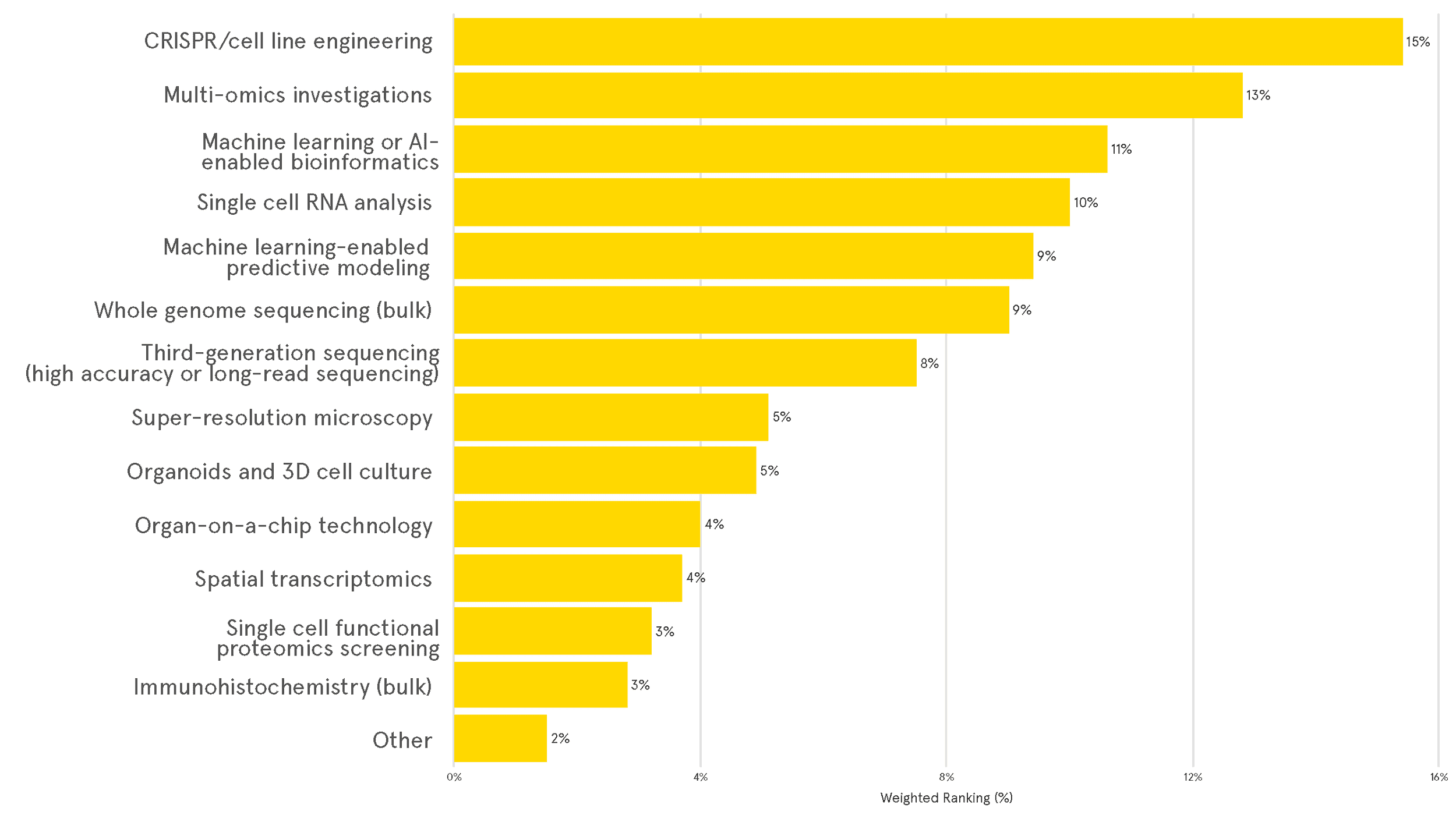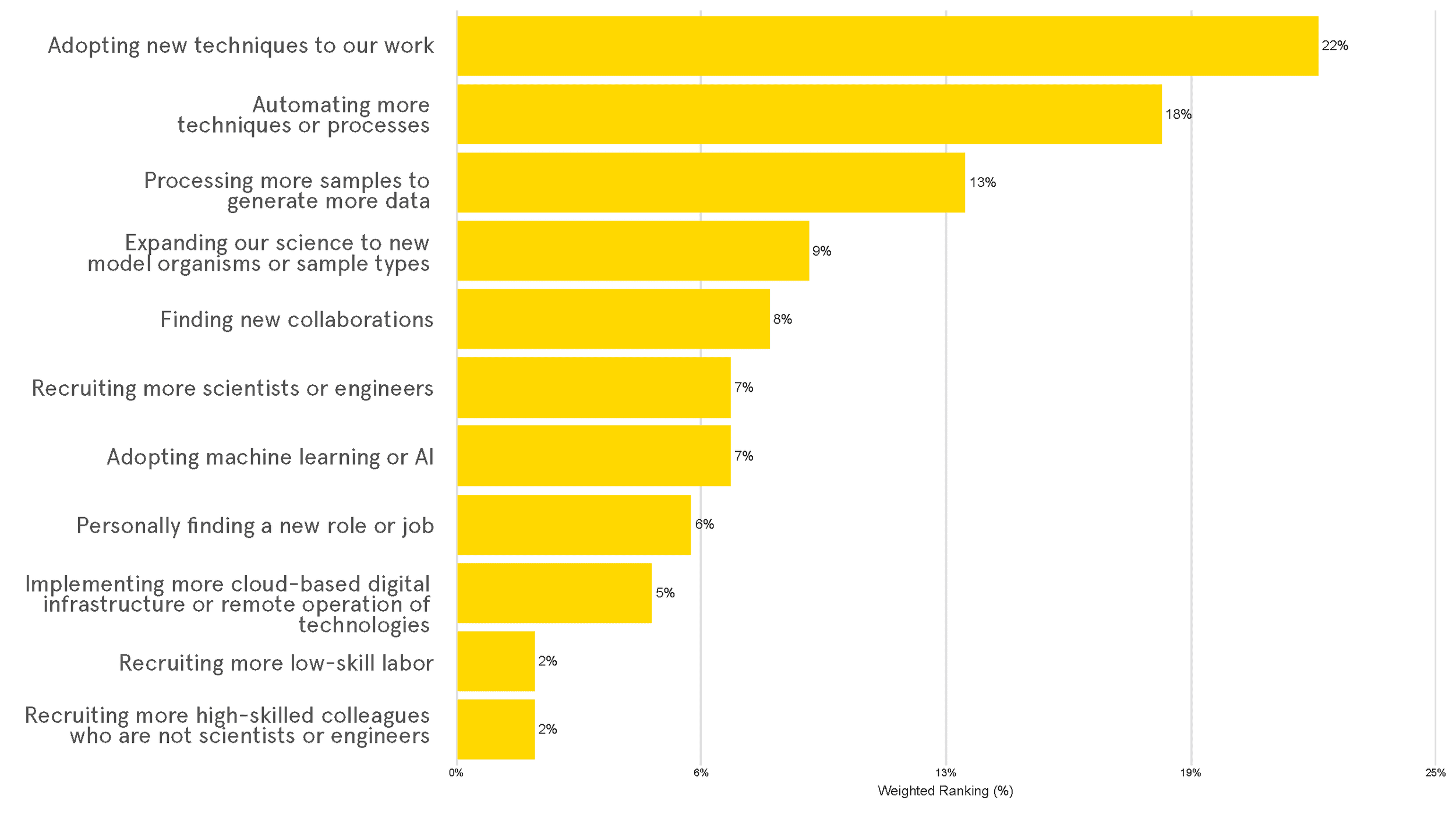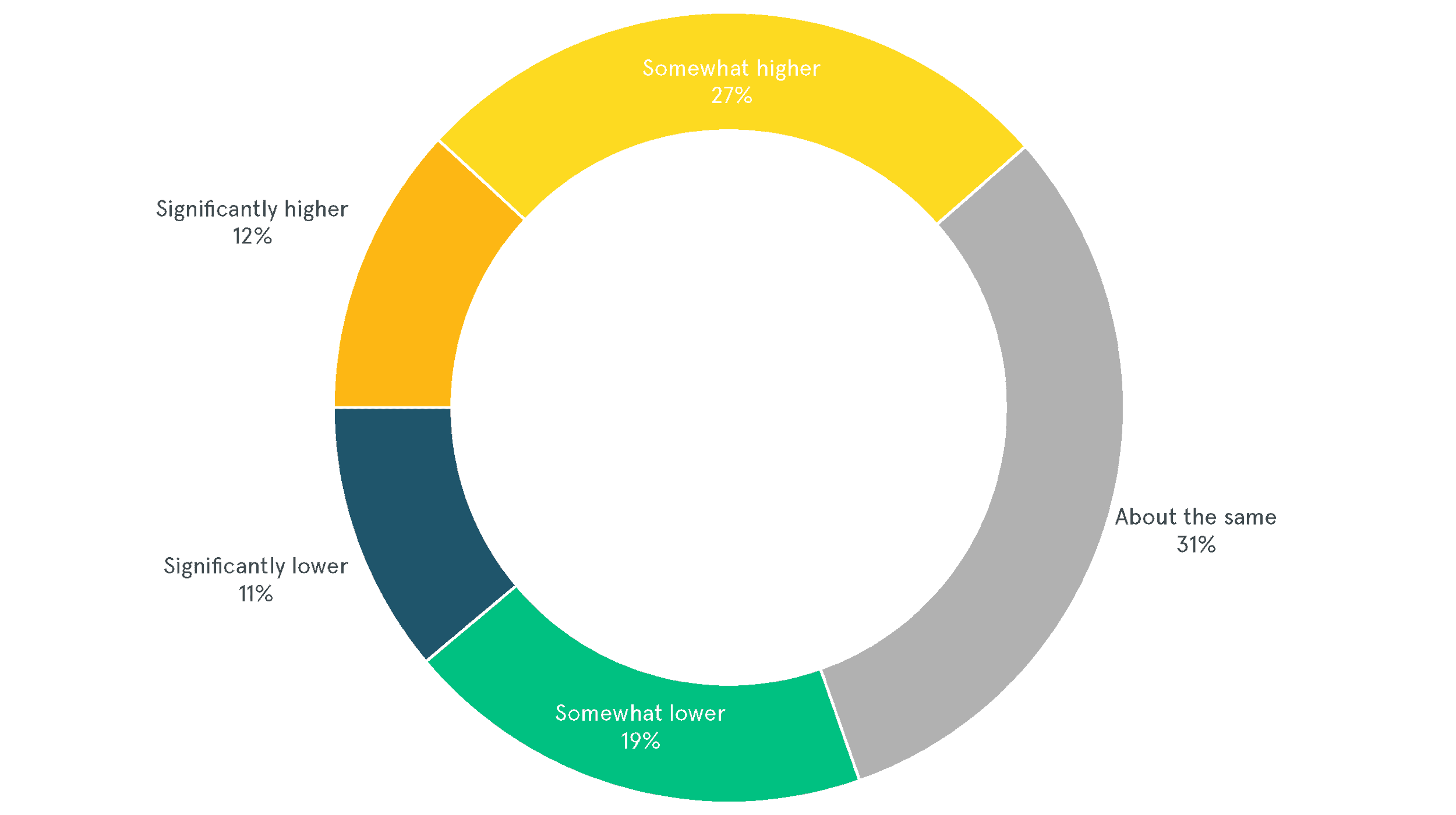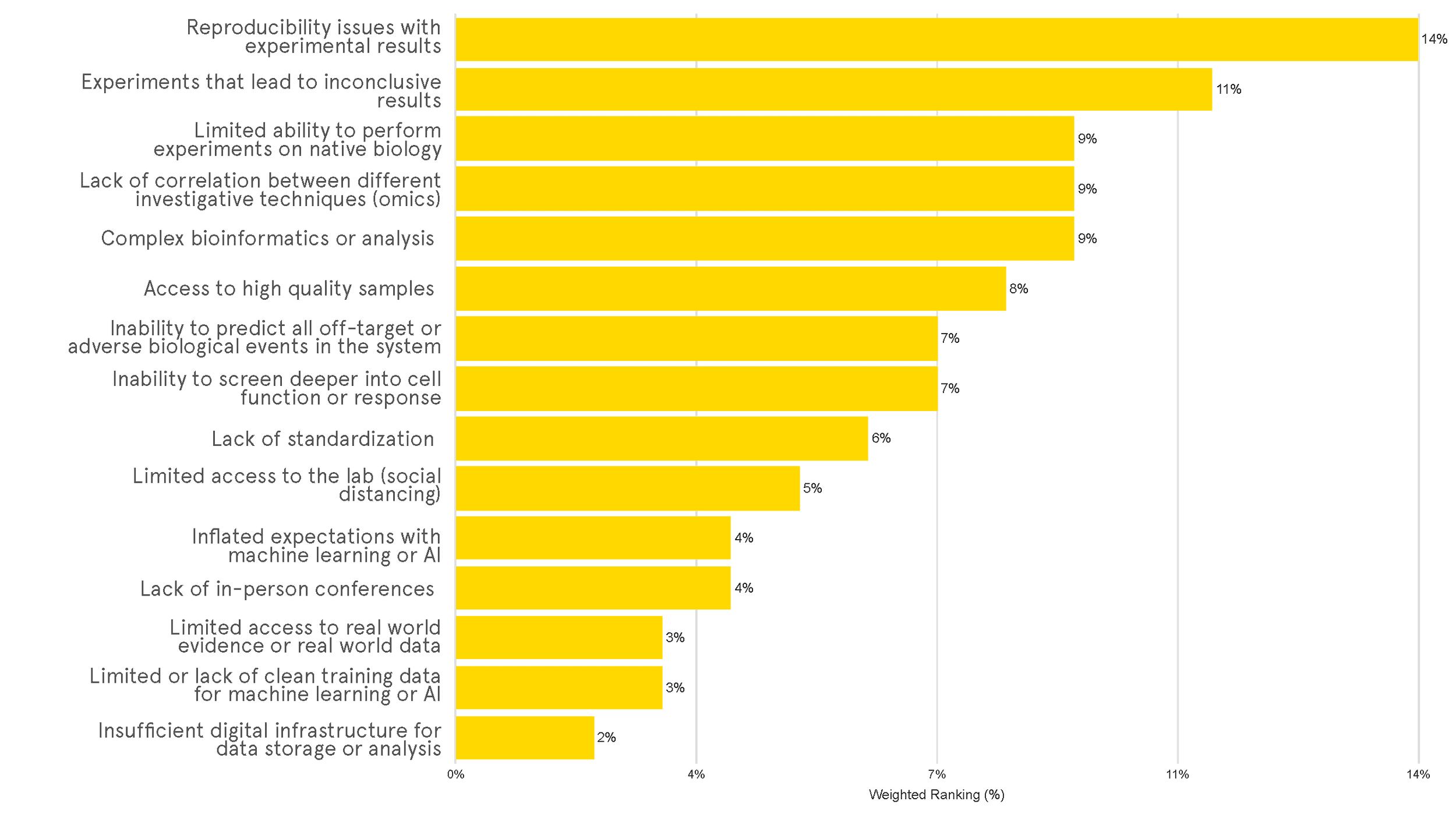SUMMARY
-
We surveyed 135 scientists around the globe to track momentum and changes in scientific priorities, barriers, purchases, and productivity
-
After being sidelined by a pandemic for two years, scientists and researchers believe they will be somewhat or significantly more productive in 2022
-
Two out of three respondents plan to purchase new technology in 2022, and ranked the scientific applications they believe will make the most significant impact this year.
-
Scientists are still struggling with several key barriers to progress, including reproducibility issues, insufficient correlation between datasets and inconclusive experimental results.
-
For organizations who want to support scientists and researchers in their scientific advancements, there’s an opportunity for businesses to support this uptick in productivity and help them overcome their obstacles
The state of science continues to evolve as organizations embrace the Next Normal. At LINUS, we track key trends and changes in the life science industry by tapping into our network of scientists around the globe to better understand and gauge what to expect in the upcoming year.
We surveyed 135 scientists globally to capture their mindset and scientific priorities in 2022 — from applications and techniques that will make the biggest impact to the technologies they do and don’t plan on purchasing, and deeper insights about how they measure productivity and the barriers they face in making progress.
About our respondents
Two thirds (66%) of our respondents work in North America, another 25% in Europe, with scientists and researchers in Asia Pacific, Central/South America, and Middle East/Africa rounding out the rest of our respondents. Nearly half (43%) of our respondents work in academic institutions (universities and medical centers), rest employed in industries related to (bio)pharmaceutical research and development and manufacturing.
Of our academia respondents, 65% work in a university with 15,000-30,000+ students.
Scientific Priorities
To understand the impact scientific advancements will make In 2022 we asked respondents to rank their top three techniques or applications in life science research and development.
Considering scientific advances, which are the top 3 techniques or applications in life science research and development do you believe will make the most significant contribution and impact in 2022? (Place a 1 next to your top choice, a 2 next to your second choice, and a 3 next to your third choice. Leave all other choices blank)
CRISPR/cell-line engineering, multi-omics investigations, machine learning or AI-enabled bioinformatics, and will make the most significant contribution to scientific advancements in the next year. Of those who selected multi-omics investigations, 59% were in academia (universities and medical centers).
This indicates a significant shift of what scientists are doing with their data and what they are prioritizing in 2022. Over a quarter of our respondents (28%) said that adopting new techniques for their work was their number one priority, followed by automating more techniques or processes, and processing more samples to generate more data. Of those who selected processing more samples to generate data, 55% were in academia (universities and medical centers).
Thinking about your own work in 2022, which of the following are your top 3 priorities? (Place a 1 next to your highest priority, a 2 next to your second priority, and a 3 next to your third priority. Leave all other choices blank)
Earlier this year, we predicted that science is on its way to closing the “correlation chasm”. The findings in this research further indicate that as science moves from a more siloed focus on DNA, RNA, or proteins to a more expansive view, scientists will shift from individual ‘omics’ to a focus on the correlation between multiple areas of study.
Measuring Productivity
In our 2021 report, Future Forward: A Special Report on Preparing for the Next Normal, respondents reported that the progression of productivity was returning to pre-pandemic levels after taking significant loss due to COVID-19 and its effects on access to labs or workplaces. Now, over a third of our respondents (39%) believe that their productivity will be significantly or somewhat higher, and another 31% said it was about the same as pre-pandemic levels, seeing a net increase in overall productivity as a result of the pandemic. However, scientists and researchers who work in industry (biopharma, pharma, biotech) believed they were more productive, compared to those in academia. For those who are in industry, 42% said their productivity has been “significantly” or “somewhat higher” compared to those in academia where only 30% said their productivity has been “significantly” or “somewhat higher”.
If pre-pandemic year 2019 was a baseline for productivity, how different do you believe your productivity will be in 2022 from that baseline?
Scientists are preparing for this productivity gain by focusing on increasing their workforce, more focus-time for experiments rather than meetings, an urgent need for their scientific work, and becoming adaptable to the next normal.
Barriers
While priorities signal attention spent on cell line engineering, multi-omics and machine learning, scientists will still have to overcome barriers that plague science: reproducibility, inconclusive experimental results, and complex bioinformatics or analysis are some of the top barriers to progress in science.
In your opinion, which of the below are the top 3 barriers in life science research and development in 2022? (Place a 1 next to your top choice, a 2 next to your second choice, and a 3 next to your third choice. Leave all other choices blank)
While not a top barrier, respondents also mentioned that a lack of correlation between different investigative techniques (‘omics) could be a significant barrier to scientific advancements in 2022.
Technology
In our research, we found that a significant number of scientists (63%) are planning to purchase new technology in 2022. Those top technologies include:
-
qPCR and PCR equipment
-
Sequencing equipment
-
Mass spectrometry equipment
-
Microscopy equipment
Those who said they will not be purchasing new technologies (37%) cited a lack of funding as the main reason they will not be purchasing new technology, followed by recent technology purchases in 2021, and the lack of expertise to develop new types of analyses.
Synthesis
Scientists are displaying a deep desire to leverage technology advances to make novel discoveries and ultimately life-enhancing products. Our research indicates that they are ready for novel study designs that enable them to overcome the complexities of biology, maximize their productivity, provide much higher confidence in reproducibility and minimize inconclusive results.
Our study shows that scientists have an appetite to work smarter, defining productivity as acquisition of or sharing knowledge, rather than throughput. Organizations that support science will gain from going beyond providing technology that generates raw data to alleviating the top three barriers that scientists face: reproducibility, conclusivity and correlation. All three of these barriers point to the value that scientists put toward generating insights and meaning from data.
We believe that 2022 will continue to bring significant advancement, and continued sophistication in scientific research, leading to potentially new business models that capture the value of such advancement.



